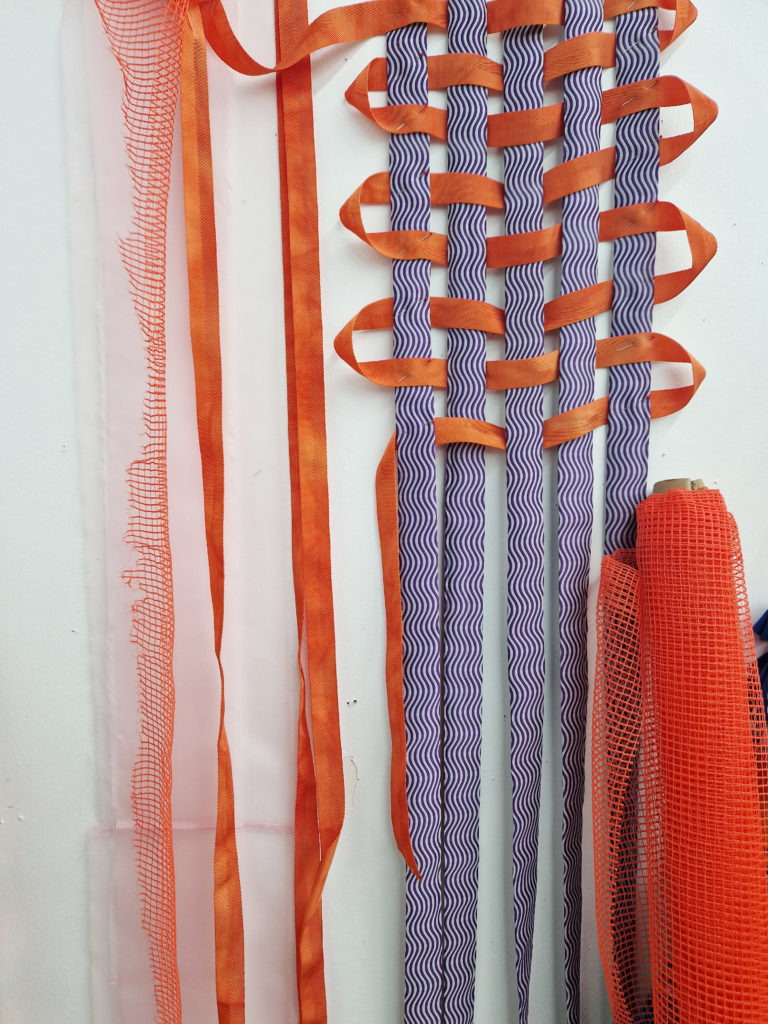WIP Artist Highlight: Amy Tidmarsh
Julie Schumacher, Artist Programs intern at TAC, got together with April WIP resident Amy Tidmarsh:
Tell me about how you came to textiles.
You know when you realize that something has always been there? I don't think I can pinpoint exactly where it originated. Both my mum and grandmother were weavers and my mum had a career as a teacher, and now she's a printmaker. I currently teach at Manchester School of Art on the Foundation course there, and amongst that, I teach undergraduate textile courses - so textiles is deeply rooted in my life.
I don't think I would have ended up in textiles had it not been for my own Foundation course that I did in Leeds in the North of England. The Foundation program in the UK are 1-year intensive courses you attend after high school. The curriculum is about helping students work out what areas of art and design they like and why. It helps break down your understanding about art and design practice and then reforms that thinking within the discipline that you're wanting to work within. It’s very simple stuff, but it's really informed how I work as a textile practitioner. I come from a design background - I have a designer's brain, but sometimes I am operating more within a fine art field. But still, design thinking (and often Foundation thinking) is at the baseline of how I work.
I think the combination of my education experiences, and my family environment formed a big part of how I came to textiles. There was something about the materials and tools that surrounded us and the processes that were inherently there. Even if I didn't understand what that big machine in the corner was (I'm talking about the floor loom at my grandparents' house) I knew that it made something. There were pieces of material that were in the house, things that my mum had made that were on the wall; there were paintings and prints that explored color. I think the creative side of color and process really was surrounding me from a young age. And I think it was the combination of the Foundation course and then my undergrad (I did the Embroidery BA at Manchester School of Art) and reinforced by my MA in Textile Design at the Royal College that confirmed how important textiles is to me. The focus on process was something that really stood out to me. I love learning—the evidence being the lace workshop I took this weekend and teaching myself how to quilt through YouTube videos—textiles to me presents some kind of brilliant nightmare that I want to get stuck into.
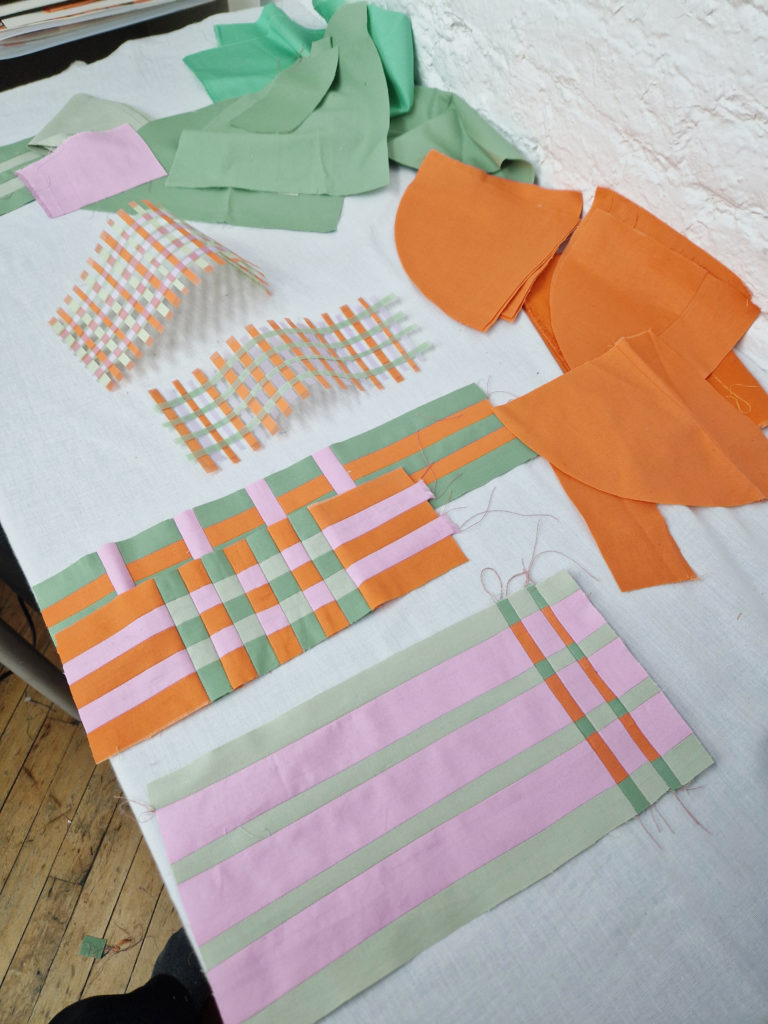
How are teaching and education important to your practice or how you experience the medium?
I think when you intuitively know your way around textiles, then actually knowing less, or being less stuck on the ‘right way’ to do something, and jumping into it can lead to exciting things and will inform how you think about the process of making the work. That's why I think creative education is so important at all levels. The process of learning a skill, understanding something, and how you can then apply it to something else is something that I'm interested in generally with my own research, alongside how I teach. My research interest lies in creativity and the learning of textile skills and where those two areas meet. I think textiles, in particular as a field, is really ripe for innovation and creativity—because of all the processes (such as knit, weave, stitch, print), and I think there is something about these creative processes that can lead to innovation. There are so many ways in which we use language to reference textile thinking. The way that we might weave an idea together or that we might combine things, fuse things—all these sort of overlaps with the language of textiles. I think it's always triggered something in my brain about physical process.
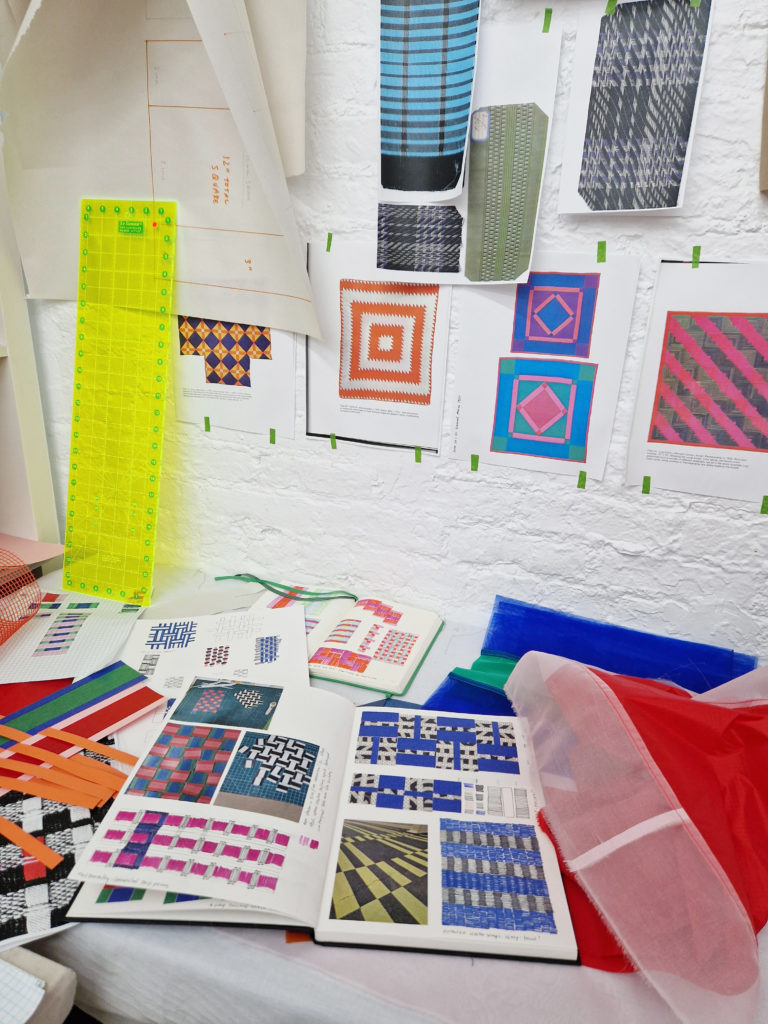
Speaking of concepts, can you tell me about what you're thinking about and interested in right now in your art practice?
I've realized how important it is to have space and time within my practices. And I think that's why I sometimes do patchwork or strip piecing, where it’s a very, very simple process and repeat it infinitely until it starts to create a surface or a form. That's the bit that I find really fascinating about textiles. And maybe the more that I make work, the more that I keep coming back to simplicity—simplicity of concept, simplicity of process—and really basic things. But that's what I'm drawn to. Whether it's colors, whether it's shapes, and actually, more and more, I’m realizing how important the stripe is as a simple element—particularly within the work that I’m focusing on at the moment.
I seem to be drawn to ways of working that are incredibly repetitive and time consuming, and I come to that idea about the type of detail that is so inherent in textiles and that we can see time in the processes, whether that is like the woven structures of braid, or if it's a stitched scene that's done by a machine or by hand or something that's been cut. I am fully invested in things that will take me a long time to do. So, if I know I've got a project where it's like, right, you now need to make a hundred of those, and each one takes you 45 minutes, I'm like: great, let's go! I think that's something that I come back to, partly through being drawn to details—details of garments, details of laces and braiding, of how things are constructed.
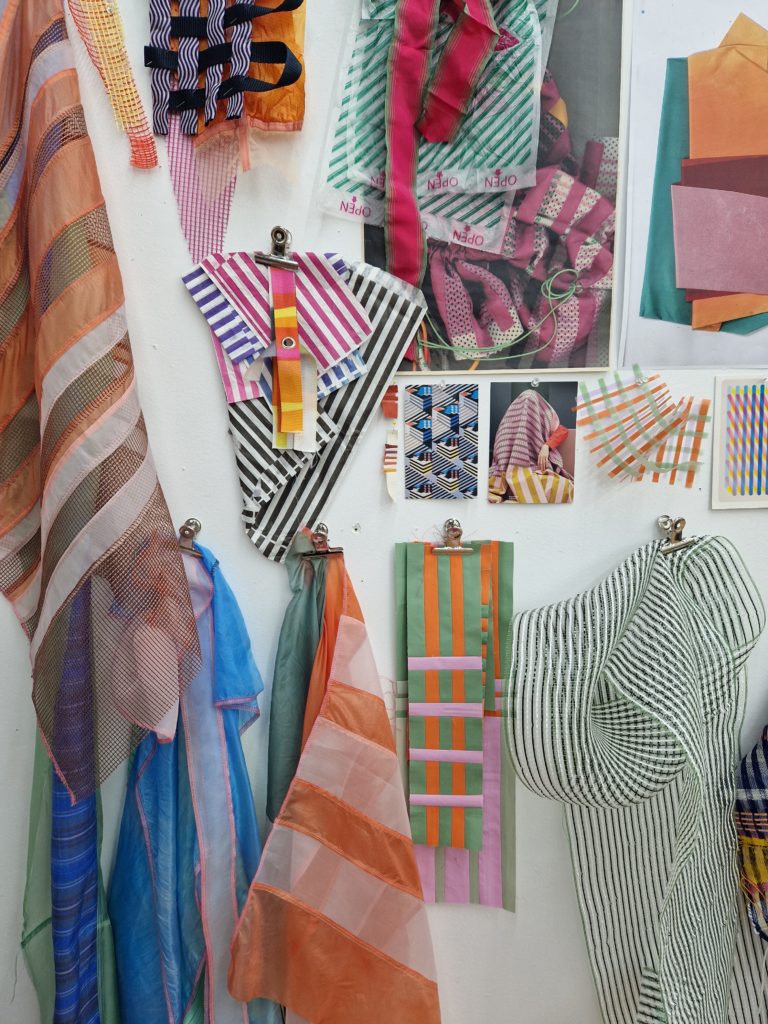
I've often wondered if it is something about the meditative nature of textiles, which is something that lots of people are drawn to, and the soothing quality of it. But I think it's also a chance for me to process my ideas. Actually, a lovely example was the bobbin lace workshop I took this weekend—it’s a new skill for me. But it was six-plus hours each day of just making. And I didn't realize how much I needed that time where I'm not necessarily thinking about things in a deep way, but I'm thinking through the actions of my body, and that in turn helps me work through my creative ideas.
This actually brings us quite nicely around to the fact that investigating the stripe is my Textile Arts Center workshop!
Yes, your TAC workshop is on April 27th—please share more!
I decided to go super, super simple. We’re going to look at and work with stripes. And to think about the potential of stripes.
This is something I come back to in my teaching: stripping things back. Not overcomplicating things and giving really clear, simple constraints of ways of working. So we're gonna be doing strip-piecing and improvised quilting and patchwork where you are not thinking too much about the design—we're not gonna have time to agonize over it. We're gonna be using the form of the stripe to dictate the design through a process of repetition and improvisation. We will also use strip-piecing, starting with striped fabrics we will then cut up in a very improvised way—it's a very interesting process because you can't think too much about it, and you have to really trust what's going on. I like to work with a few fabrics so that therefore, the design becomes more complicated as you go. You start with one stripe, and then by the end of it, you might have 20, 25. So it'll be quite experimental sampling that we’ll do in three hours that might lead you to think about composition and design in different ways. Equally, this is a good way of thinking about color and patterning and how you can control it while manipulating it.
This links nicely with what I have been looking at during the residency: taking some simplistic quilting and weaving samples and actually scaling them up, challenging the materials and translating them through the process of patchwork. I'm interested in the stripes that are commonly found in weaving and in patchwork, specifically American patchwork and classical weaving patterns. There are lots of quilt blocks that reference weaving, basketry-type structures, and there are really interesting woven patterns that also almost amplify the woven structure that's already in the fabric. In this workshop and over the month, I want to turn up the volume and also simplify it.
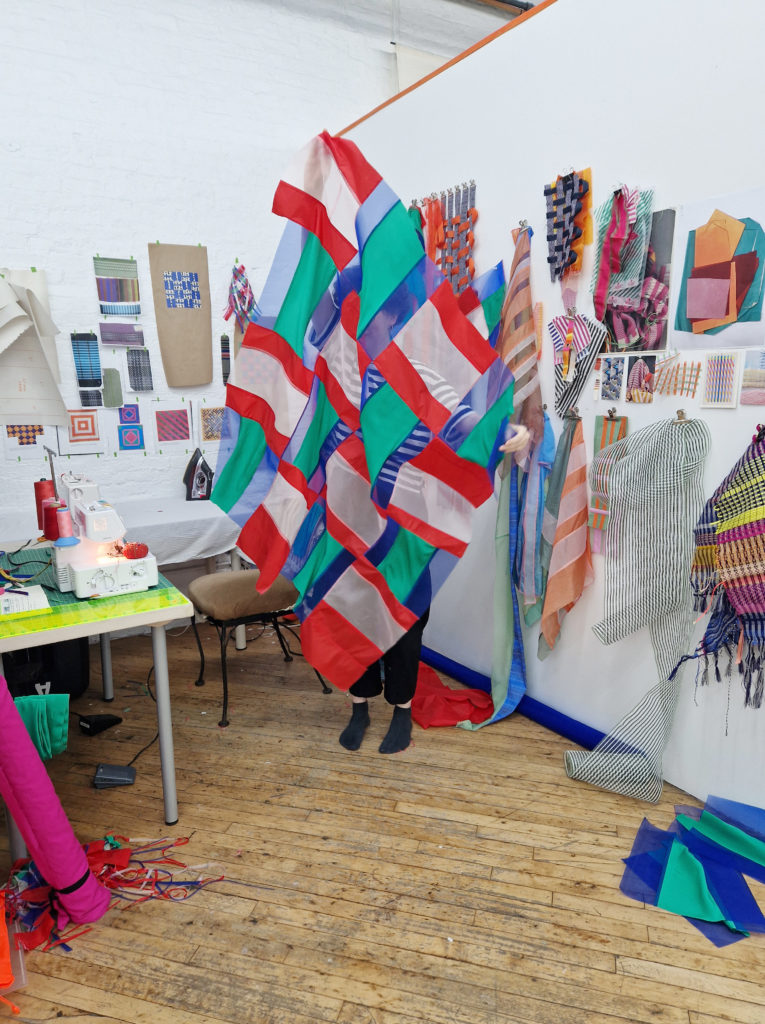
It seems like color is a key element of your work, and you do a lot of layered colors. Is that an intentional through-line in your work?
Yes, completely. If I was to really simplify it down, it's all about the graphic quality of the stripe and the exploration and nuances of color combinations and how colours interact. I am interested in how the translucency of the materials can create new colors. So when you have a pink chiffon over top of another color, it might dirty or muddy it, that's where it became really important for me to be able to find the balance between a control of color, and sort of an intuitive, playful quality of it. I'm often working with found, existing materials, and then other times I am dying or working with more control over it. Then, a lot of it is about what happens when they sit next to each other or when you have space between them—or an overlay. Then you have this lovely optical color mixing effect that happens.
So, whilst quilting and patchwork have become almost like a methodology for making, I'm not really making quilts. Essentially, it's about the cutting up and re-piecing of things in a visual way to create structure, but also really going back to that idea about fundamentals, like the simplicity of color next to each other.
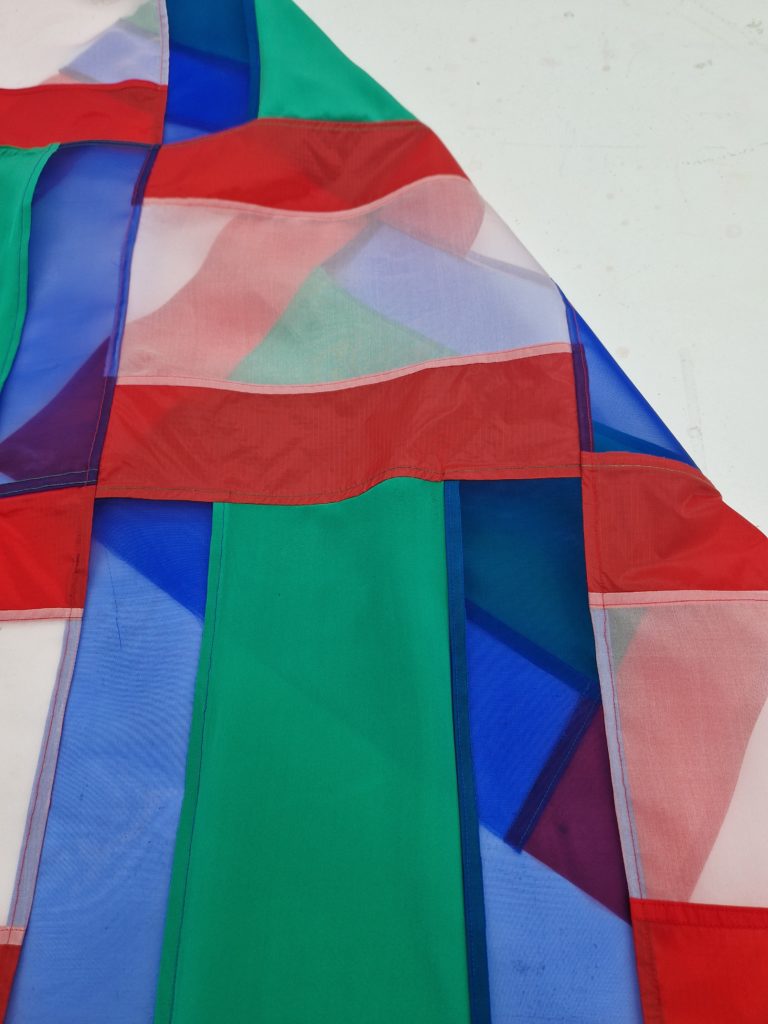
What other elements are important to you in your work?
I love it when fabric and textiles are three-dimensional and I’ve done some performance work with that. To me, it's really important for fabric to drape or to hang, so you can see the fact that it's got a structure to it—that it has integrity somehow.
I also quite like the contrast of materials, and how that contrast changes how they hold, how they've got that structure. Taking this woven 3D structure into this flat graphic image, then taking it back into 3D is almost like a translation of process.
So would you say your works are more sculpture than anything? Or paintings? Installation?
That is an ongoing question to myself, which I'm still trying to work out. I feel like I've spent the past few years trying to work out where I sit in terms of context—collaborating with fashion designers, making sort of more one-off art pieces, making quilts. This idea—is it a thing? Does it have a function? It’s a tension to me that I want to make it into a thing, but I don't feel like I have the skills. So then I often have these large samples, but I have realised (through this residency in fact) that actually they are the work in itself. That the textiles is the work - it is somehow like a painting or sculpture in itself, that can take up space or interact with people. I want to keep exploring what this means to me.
